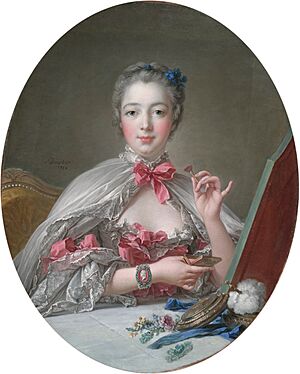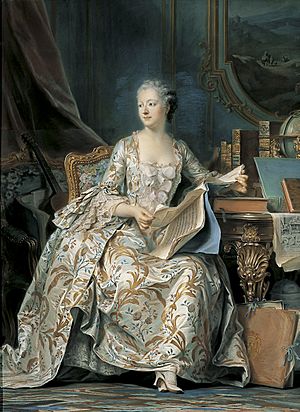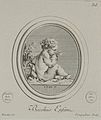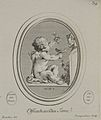Madame de Pompadour facts for kids
Quick facts for kids
Madame de Pompadour
|
|
|---|---|
| Marquise of Pompadour | |

Portrait by Charles-André van Loo, ca.1755
|
|
| Coat of arms |  |
| Full name |
Jeanne Antoinette Poisson
|
| Born | 29 December 1721 Paris, Kingdom of France |
| Died | 15 April 1764 (aged 42) Paris, Kingdom of France |
| Buried | Couvent des Capucines |
| Spouse(s) |
Charles Guillaume le Normant d'Étiolles
(m. 1741) |
| Issue |
|
| Father | François Poisson |
| Mother | Madeleine de La Motte |
| Signature | |
| Occupation | Chief mistress of Louis XV |
Jeanne Antoinette Poisson, Marquise de Pompadour (born December 29, 1721 – died April 15, 1764), known as Madame de Pompadour, was an important person at the French royal court. She became the official royal companion and close advisor to King Louis XV from 1745 until her death.
Madame de Pompadour managed the King's schedule and was a trusted helper and advisor. She gained noble titles for herself and her family. She also built a network of friends and supporters at court. She was careful to get along well with the Queen, Marie Leszczyńska. In 1756, she was even named a top lady-in-waiting to the Queen. This was a very respected position at court.
Pompadour was a big supporter of architecture and decorative arts, especially porcelain. She also supported thinkers of the Age of Enlightenment, like Voltaire. While some people at the time criticized her influence, historians today often see her as a successful patron of the arts. They also see her as someone who boosted French pride.
Contents
Early Life of Madame de Pompadour
Jeanne Antoinette Poisson was born in Paris on December 29, 1721. Her father was François Poisson and her mother was Madeleine de La Motte. It is thought that her biological father might have been a rich financier named Jean Pâris de Monmartel. Another possible father was the tax collector Charles François Paul Le Normant de Tournehem.
When Jeanne Antoinette was five, she went to an Ursuline convent in Poissy for her education. She was known for being smart and charming. In 1730, at age nine, she returned home due to poor health. A fortuneteller told her mother that Jeanne Antoinette would one day rule the heart of a king. From then on, she was called Reinette, meaning "little queen." She was prepared to become a companion to King Louis XV.
Her guardian, Tournehem, arranged for her to have private lessons at home. She learned dancing, drawing, painting, and theater. She could even memorize entire plays. This special education led to rumors that Tournehem was her father.
Marriage and Family
At age nineteen, Jeanne Antoinette married Charles Guillaume Le Normant d'Étiolles. He was the nephew of her guardian, Charles Le Normant de Tournehem. Tournehem arranged the marriage and provided a lot of money. In 1740, Tournehem made his nephew his only heir. This included the Étiolles estate, a wedding gift. It was near the royal hunting grounds.
Charles Guillaume loved his wife very much. She told him she would never leave him, unless it was for the King. The couple had a son who died as a baby. They also had a daughter, Alexandrine Le Normant d'Étiolles, born in 1744. Sadly, Alexandrine died at age nine.
Attending Parisian Salons
As a married woman, Jeanne Antoinette could visit popular social gatherings called salons in Paris. These were hosted by important women like Mesdames de Tencin and Geoffrin. In these salons, she met famous thinkers of the Enlightenment. These included Voltaire, Montesquieu, and Bernard de Fontenelle.
Jeanne Antoinette also started her own salon at Étiolles. Many cultural leaders attended, including Voltaire. In these groups, she learned how to have clever conversations. This skill later made her well-known at the Palace of Versailles.
Meeting King Louis XV
Because of her charm and beauty, King Louis XV heard about Jeanne Antoinette as early as 1742. In 1744, she tried to get the King's attention during a hunt. Her estate was near the royal hunting grounds. She drove her carriage directly in front of the King's path. Once she wore a blue dress in a pink carriage, and another time a pink dress in a blue carriage. The King sent her a gift of venison.
The King's current companion, Maria Anne de Mailly, died in December 1744. On February 24, 1745, Jeanne Antoinette was invited to a masked ball. This ball was held at the Palace of Versailles. It celebrated the marriage of the King's son, Louis of France. At this ball, the King, disguised as a yew tree, showed his interest in Jeanne Antoinette. She was dressed as Diana the Huntress, a nod to their meeting in the forest.
Introduction to the Royal Court
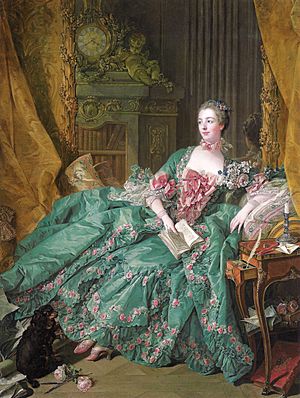
By March, she became the King's companion. She moved into an apartment at Versailles, right above his. On May 7, her official separation from her husband was announced. To be presented at court, she needed a noble title. The King bought the marquisate of Pompadour on June 24. He gave the estate and title to Jeanne Antoinette, making her a Marquise.
On September 14, 1745, Madame de Pompadour was formally introduced to the King. The King's cousin, the Princess of Conti, presented her. Jeanne Antoinette wanted to secure her place at court. She immediately tried to build a good relationship with the royal family. She promised respect and loyalty to Queen Marie Leszczyńska. The Queen, in turn, preferred Jeanne Antoinette over the King's other companions. Pompadour quickly learned the strict court rules. Sadly, her mother died on Christmas Day that year. She did not live to see her daughter become the undisputed royal companion.
A Powerful Royal Companion
As the King's favorite, Pompadour gained great power and influence. In 1752, she was made a duchess. In 1756, she became a lady-in-waiting to the Queen. This was the highest rank a woman could have at court. Pompadour acted almost like a prime minister. She helped decide who got promotions, favors, and dismissals. She also played a role in French politics, both at home and with other countries.
In 1755, a diplomat from Austria, Wenzel Anton, Prince of Kaunitz-Rietberg, asked her for help. He wanted her to get involved in talks that led to the Treaty of Versailles. This treaty changed alliances in Europe. France, which used to be enemies with Austria, now became allies.
This change led to the Seven Years' War. France, Austria, and Russia fought against Britain and Prussia. France lost a battle to the Prussians in 1757. They also lost their American colonies to the British. After the loss, Madame de Pompadour is said to have told the King: "After us, the Deluge" (meaning, "After us, who cares what happens?"). France ended the war weaker and almost bankrupt.
Madame de Pompadour continued to support these policies. She helped bring Choiseul into office and guided him. She supported his plans, including the Treaty of Paris (1763). Britain's wins in the war made it the top colonial power. Many people blamed Pompadour for this.
Pompadour also protected the Physiocrates school of thought. She also defended the Encyclopédie, a famous book series. She protected it from those who wanted it banned. The authors of the Encyclopédie portrayed Pompadour in a positive way. This was likely to ensure her support.
Many royal courtiers disliked the Marquise. They felt it was wrong for the King to be so close to someone not born into the nobility. She was very sensitive to the constant insults written about her. These insults were called poissonnades, a play on her family name, Poisson (meaning "fish").
A Trusted Friend to the King
Madame de Pompadour had a lot of influence because she was a valuable friend to the King. Unlike previous royal companions, Pompadour made herself very important to Louis. She became the only person he truly trusted. She was also the only one who would tell him the truth. Louis often felt sad and bored. Pompadour was an essential comfort to him. She could always entertain and amuse him. She would host elegant private parties and operas. Sometimes, even the Queen, Marie Leszczyńska, would attend. They also enjoyed hunting and visiting their various estates.
Around 1750, Madame de Pompadour's main role became that of the King's trusted friend.
Supporting the Arts
Madame de Pompadour was a very important supporter of the arts. She helped make Paris known as the center of taste and culture in Europe. She gained this influence because her guardian, Charles François Paul Le Normant de Tournehem, was put in charge of government spending for the arts. Later, her brother, Abel Poisson, took over this role.
She showed French pride by building and then buying a porcelain factory at Sèvres in 1759. This factory became one of the most famous porcelain makers in Europe. It also provided skilled jobs for people in the area. Pompadour supported many sculptors and portrait painters. These included the court artist Jean-Marc Nattier and François Boucher. She also supported Jacques Guay, a gemstone engraver. He taught her how to engrave on stones like onyx and jasper.
Pompadour greatly influenced the "Rococo" style in art and decoration. For example, she supported artists like Boucher. She also constantly redecorated the fifteen homes she shared with Louis. This style was sometimes criticized as being too "feminine." However, many men also liked it. Madame de Pompadour used her support of artists to get the King's attention. She also used it to build her public image.
Besides supporting the arts, Pompadour also took part in them. She was one of the few people in the 1700s who engraved gemstones. She was also a praised actress in plays at her private theaters. These were at Versailles and Bellevue. She even had engraving tools in her apartments at Versailles. She used them to create prints of works by Boucher and Guay.
Her large book collection also showed her clever mind. She owned important books, like the History of the Stuarts. This book was printed in 1760 using her own printing press. Her personal library showed her wide interests.
Madame de Pompadour's Artwork
Madame de Pompadour created 52 engraved prints. These were based on drawings by Boucher and gemstone engravings by Guay. Her collection of work is called "Suite d'Estampes Gravées Par Madame la Marquise de Pompadour d'Apres les Pierres Gravées de Guay, Graveur du Roy." This means "Series of Prints engraved by Madame la Marquise de Pompadour after the engraved stones of Guay, engraver of the King."
Her personal collection of artwork was found in the Walters Art Museum. Some art historians debate how much Pompadour contributed to these works. It's not clear whose ideas or compositions they were.
Here are some museums and libraries that have a copy of her artwork collection:
- Walters Art Museum, Baltimore
- Met Museum, New York
- British Museum, London
- Boston Museum of Fine Arts
- Bibliothèque de l'Arsenal, Paris
- Rothschild collection, Louvre
- Bibliothèque de Troyes
Death of Madame de Pompadour

King Louis XV remained dedicated to Pompadour until she died. She passed away from tuberculosis in 1764, at age forty-two. Louis cared for her during her illness. Even her enemies admired her bravery during her last difficult weeks. Voltaire, a famous writer, wrote that he was very sad about her death. He said it seemed strange that he, an old writer, was still alive, but a beautiful woman in a great career had died so young.
Many of her enemies, however, felt relieved. As her coffin left Versailles, the King saw the rain. He reportedly said: "The marquise will not have good weather for her journey." She was buried at the Couvent des Capucines in Paris.
Madame de Pompadour in Film and TV
Madame de Pompadour has been shown in many movies and TV shows. Her first appearance was in 1924 in Monsieur Beaucaire. A movie called Madame Pompadour came out three years later.
Other actresses who have played her include:
- Anny Ahlers (Madame Pompadour, 1931)
- Doris Kenyon (Voltaire, 1933)
- Geneviève Page (Fanfan la Tulipe, 1952)
- Micheline Presle (Royal Affairs in Versailles, 1954)
- Sophia Myles (as an adult) and Jessica Atkins (as a child) in "The Girl in the Fireplace", an episode of Doctor Who, 2006.
- Hélène de Fougerolles (Jeanne Poisson, marquise de Pompadour, TV 2006)
- Bojana Novakovic (Casanova, 2015)
See also
 In Spanish: Madame de Pompadour para niños
In Spanish: Madame de Pompadour para niños


